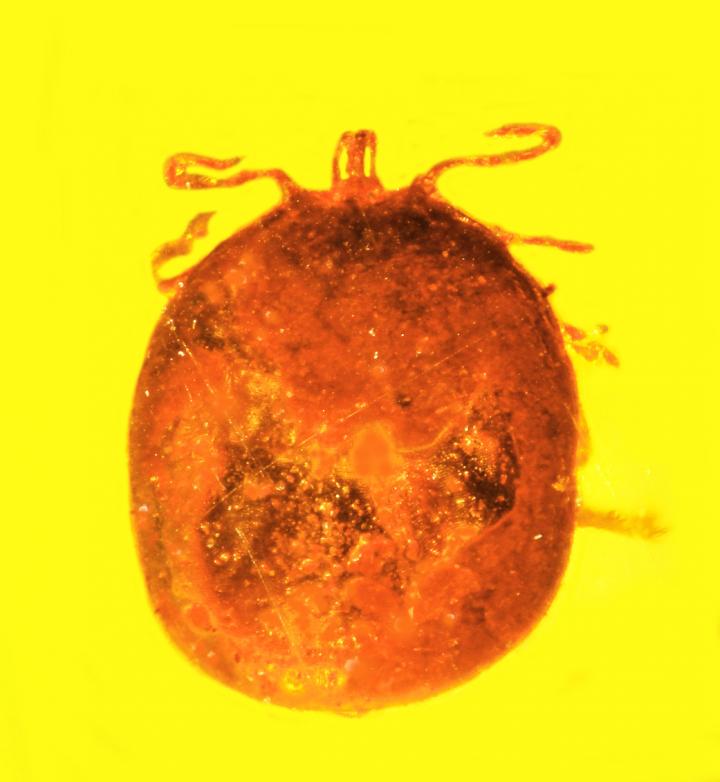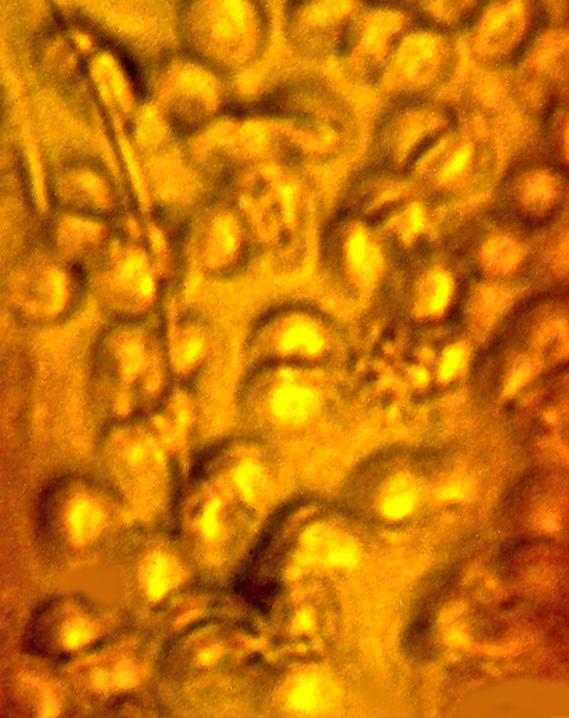
The only known example of ancient mammalian red blood cells preserved in amber may exist, thanks to a bit of monkey business.
The cells were found in a fossilized tick that had been gorging on a blood meal when it was unceremoniously removed midfeed and plunked in sticky amber. A subtle feature on the tick's back suggests that an ancient monkey that was grooming one of its friends removed the tick.
"Two tiny holes indicate that something picked a tick off the mammal it was feeding on, puncturing it in the process and dropping it immediately into tree sap," study co-author George Poinar Jr., an amber expert and professor emeritus at Oregon State University, said in a statement.
Examination of the gorgeously preserved specimen also reveals the presence of myriad parasites in the tick's gut. In modern times, similar parasites, such as Babesia microti, infect the blood cells of mammals ranging from humans to cattle.
"The fossilized blood cells, infected with these parasites, are simply amazing in their detail. This discovery provides the only known fossils of Babesia-type pathogens," Poinar said. [In Images: Human Parasites Under the Microscope]
Ancient find
The fossil was found in mines in the Cordillera Septentrional mountain range of the Dominican Republic. Based on dating of algae and single-celled plankton covered in calcium-carbonate plates, which were found in the same area, the amber likely dates to between 15 million and 45 million years ago, according to the study, which was published online March 20 in the Journal of Medical Entomology. During that time period, the area would have been a thick tropical jungle.
The amber created a truly unprecedented level of preservation. The red blood cells were frozen inside the tick's gut in various stages of digestion. The amber also revealed the presence of many single-celled parasites, in different parts of their life cycle. Thanks to the differences in texture and weight between the parasite and the red blood cells, the amber naturally stained the parasites. Consequently, they appear like darker, signet-ring-shaped structures against the lighter-colored red blood cells.
Sign up for the Live Science daily newsletter now
Get the world’s most fascinating discoveries delivered straight to your inbox.

The red blood cells were too big to have belonged to most mammals; the size ruled out everything but dogs, rabbits and similar creatures or primates. However, rabbits and dogs did not live in the region at that time, while paleontologists have recovered numerous primate fossils dating roughly to the same ages. So a primate is the likeliest host for the tick — and primates are known for grooming each other.
Based on the shapes and structures formed from many cells of the parasites, Poinar pegged them as belonging broadly to the order Piroplasmida, likely from either the Babesia or the Theileria genus. Mammals today, from humans to cattle, can be infected with Babesia microti, which causes nonspecific, flu-like symptoms in humans, according to the Centers for Disease Control and Prevention.
"The life forms we find in amber can reveal so much about the history and evolution of diseases we still struggle with today," Poinar said. "This parasite, for instance, was clearly around millions of years before humans, and appears to have evolved alongside primates, among other hosts."
Originally published on Live Science.

Tia is the managing editor and was previously a senior writer for Live Science. Her work has appeared in Scientific American, Wired.com and other outlets. She holds a master's degree in bioengineering from the University of Washington, a graduate certificate in science writing from UC Santa Cruz and a bachelor's degree in mechanical engineering from the University of Texas at Austin. Tia was part of a team at the Milwaukee Journal Sentinel that published the Empty Cradles series on preterm births, which won multiple awards, including the 2012 Casey Medal for Meritorious Journalism.









